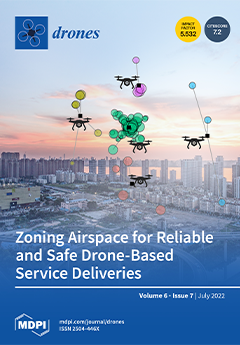Given the stagnating progress in the fight against malaria, there is an urgent need for area-wide integrated vector management strategies to complement existing intra-domiciliary tools, i.e., insecticide-treated bednets and indoor residual spraying. In this study, we describe a pilot trial using drones for
[...] Read more.
Given the stagnating progress in the fight against malaria, there is an urgent need for area-wide integrated vector management strategies to complement existing intra-domiciliary tools, i.e., insecticide-treated bednets and indoor residual spraying. In this study, we describe a pilot trial using drones for aerial application of Aquatain Mosquito Formulation (AMF), a monomolecular surface film with larvicidal activity, against the African malaria mosquito
Anopheles arabiensis in an irrigated rice agro-ecosystem in Unguja island, Zanzibar, Tanzania. Nine rice paddies were randomly assigned to three treatments: (a) control (drone spraying with water only), (b) drone spraying with 1 mL/m
2, or (c) drone spraying with 5 mL/m
2 of AMF. Compared to control paddies, AMF treatments resulted in highly significant (
p < 0.001) reductions in the number of larvae and pupae and >90% fewer emerging adults. The residual effect of AMF treatment lasted for a minimum of 5 weeks post-treatment, with reductions in larval densities reaching 94.7% in week 5 and 99.4% in week 4 for the 1 and 5 mL/m
2 AMF treatments, respectively. These results merit a review of the WHO policy regarding larval source management (LSM), which primarily recommends its use in urban environments with ‘few, fixed, and findable’ breeding sites. Unmanned aerial vehicles (UAVs) can rapidly treat many permanent, temporary, or transient mosquito breeding sites over large areas at low cost, thereby significantly enhancing the role of LSM in contemporary malaria control and elimination efforts.
Full article





